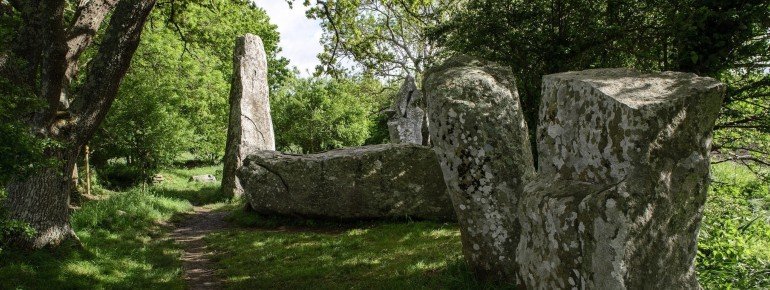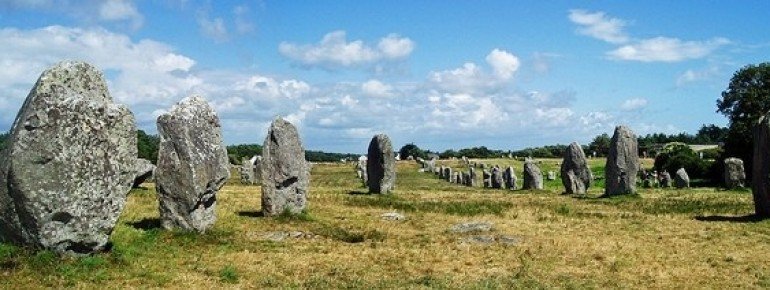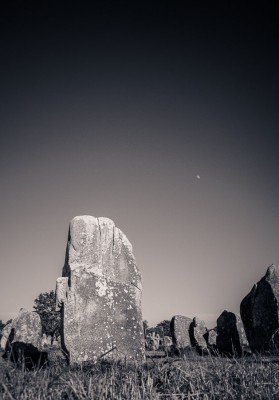Contents
Description

A village of stones
Carnac is a little French village on the coast of the Atlantic Ocean within the Département Morbihan and is known for more than 3,000 menhirs that rise high above the heath and leave impressive marks all over the area. The individual stones from regional granite were arranged in four groups and arrayed in rows. These stone rows are also called alignments and stretch out across four kilometers. To be more specific, a stone alignment is a linear arrangement of upright, parallel megalithic standing stones set at intervals along a common axis usually dating from the later Neolithic or Bronze Age. These stones are between a half a meter and four meters high and together form the largest megalithic site in the world. Each set is organized with the tallest stones at the western and the shorter ones at the eastern end. The so called Le Menec, Kerlescan and the Kermario are considered to be among the most impressive menhirs. Visitors from all over the world are charmed by this seemingly mysterious place up until today.
Menhires, Allignments and Dolmens
Whoever visits Brittany will not be able to miss these monumental signs of the Neolithic. Hence, a short explanation: A menhir (the word can be linked back to the French: men, "stone" and hir, "long”) is a large upright standing stone . These stones can be up to 20 meters in height and can weigh more than 350 tons. Menhirs may be individual or grouped, while three or more stones aligned can constitute a stone alignment. The ends of each stone row were marked with a half circle of menhirs. A dolmen is a type of single-chamber megalithic tomb, usually consisting of two or more upright stones supporting a large flat horizontal capstone. Because of the look of it, the nickname of dolmens is “ stone table”.
Visiting the stone rows
To protect the megalithic structures from any damage they were fenced in the 1990s and are now listed for historic preservation. The great amount of visitors of the sight caused the ground to be loosened which threatened the stones to fall. Nowadays you have two options: You may either gaze at the natural sight from the fence a bit further away, or you can alternatively take the official guided tour to get really close to the menhirs. For further information about the history of the stones it is worth it to visit the prehistoric museum located right in downtown Carnac.
Historical Information
The Megalith culture
The megalith culture has its origins in the regions by the coastlines of the Atlantic Ocean. Carnac is next to Stonehenge the second most known sight for the megalith phenomenon. The alignments of Carnac were probably built between the years 5,000 and 3,000 years BC and were first mentioned around the years 2,300 BC. Furthermore, the size of the former stone rows was much larger than the one we see today and connected even more alignments. While the old megaliths were treated in the early years, the newer ones rarely show signs of work done by human hand. However, the megalith cult disappeared the same way it showed up: very quickly. Individual stones were converted in something else when the culture deserted. That's how you can still find some stones in Christian sanctuaries of France, as the Catholic church decorated some stones with their own symbols.
The theories behind the constructions
The menhirs of the Atlantic region count as one of the mysteries yet unsolved even as of today. There is a horrendous amount of theories and sagas around these ancient stones. The most mentioned theories include either an astronomical, a religious or a calendrical premise. Other theories talk about the menhirs being a form of protection against aliens. Further, they may have been used as a public veneration of the dead, as border marks or as a form of sacred landscaping. Some scientists say that the creators of the megalithic cult were sailors, due to the proximity to the ocean.
These theories are especially hard to prove right since from all the stones only a third is located by its origin. What must be true however, is the fact that it took the cooperation of many people to move these enormous stones to one place. That lets one conclude, that the people back then must have been highly cultivated already.
How to get there

By car
The megaliths can be found all around the village Carnac. Follow the E60 to Auray from Lorient or Vanne. Next, turn onto the D768 in the direction of Plouharnel. After about five kilometers take the D119 that leads your way directly to Carnac. You will get to see the first stone alignments shortly before reaching the charming little town. Turn right once more onto the D196 to reach the largest set of standing stones called “Allignements de Carnac“ by Le Ménec.














